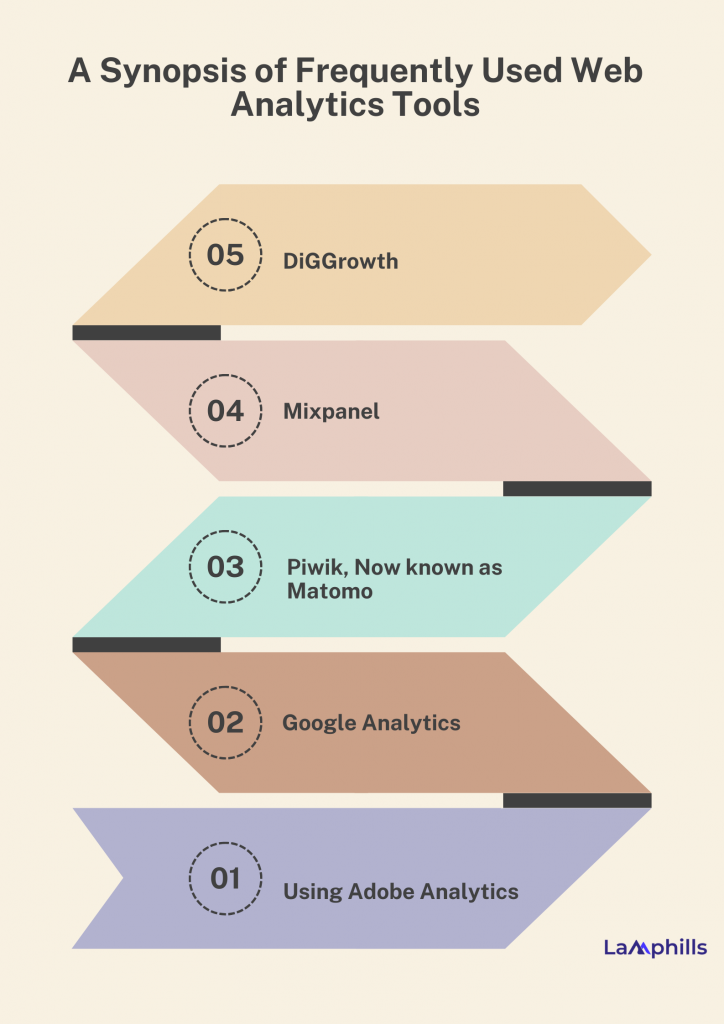Have you ever wondered what happens to your website’s visitors when they are on your platform? The pages they visit the most, how they interact with them, and their path from one page to the other. Understanding their path, preferences, and places of engagement is essential for making informed decisions and enhancing your online presence. However, how can these insights be found? Web analytics, a powerful technology that transforms user data into strategic insights, is key.
But how can we turn unprocessed data into insightful and profitable knowledge? Web analytics tools are essential for making sense of everything while gathering data ethically. So, in this article, I’ll have covered tips on advancing your digital marketing plan and the best web marketing analytics tools, methods, and practices to implement.
Key Points
- Web marketing analytics is about tracking and analyzing how people interact with your website to improve it and achieve business goals.
- Common metrics include page views, unique visitors, bounce rate, and traffic sources, which give insights into website performance and user behavior.
- Popular web analytics tools include Google Analytics, Adobe Analytics, Matomo (formerly Piwik), Mixpanel, and DiGGrowth, each offering different features and capabilities.
- Regular data review and analysis are essential to identify trends and areas for improvement in your digital marketing efforts.
- Data privacy and compliance with regulations like GDPR are critical considerations when implementing web analytics to maintain user trust and avoid legal issues.
What is Web Marketing Analytics?
Web marketing analytics is the practice of recording, examining, and reporting data produced by users’ interactions with a website and its various elements—such as its web pages, photos, and videos—to deliver practical insights that will assist the website owner in meeting commercial goals like more traffic, conversion rates, or sales while also optimizing the site for users.
Making decisions to accomplish a goal is easier when user behavior data from a website or web application is gathered and analyzed. Web browsers are used by analytics tools to watch and evaluate online activity. The tools then produce information in formats that are easy for humans to understand, such as tables, charts, or graphs.
The Importance of Web Marketing Analytics
Web marketing analytics is an essential component of your company’s success. It helps you better understand your website’s users and apply those insights to enhance their experience. For instance, if most visitors use mobile devices, you can concentrate on making your website more mobile-friendly.
Your content and SEO strategy will also be shaped by web analytics. You can start determining what material and themes resonate most with your audience by looking at your most popular pieces. You can change and focus your attention from definition articles about anything web-related to how-to WordPress tutorials if you observe, for example, that most of your most popular pieces are how-to WordPress tutorials. Perhaps you examine the sources of traffic to your website and see that paid channels bring in the least traffic while organic and email traffic are your main sources. If so, you can decide to reallocate resources so that you devote more to your organic strategy than to paid advertising.
Now that we know what web analytics is and why it matters let’s take a closer look at some of the most essential indicators you may monitor to see how well you’re achieving your main goals, which could include raising website traffic, leads, and sales.
Optimizing your digital marketing approach requires knowing where visitors to your website are coming from. You may use this template to analyze your traffic sources and determine which results in the highest traffic, engagement, and conversion rates. You may increase overall marketing success by using the template below to track and compare the performance of various traffic sources and allocate resources more wisely.
Traffic Source Analysis Template.pdf
Examples of Web Marketing Analytics
Before continuing, it’s vital to remember that different analytics systems may define the following phrases slightly differently. The best way to determine how each is computed precisely is to consult the manual for your specific analytics tool.
#1. Views Per Page
The total number of times a page on your website has been visited is called a pageview. When a browser loads a page on your website, you get credited with a page view (or view). Therefore, it would be considered two views if someone visited a page on your website and reloaded it in their browser. Three views would be recorded if someone visited your website, viewed one page, then viewed another, and then went back to the initial page.
Pageviews can help you gauge the popularity of a page on your website, but it’s crucial to consider this figure in relation to other metrics, which is something a traffic analysis tool can assist you with. A page with many views for a post doesn’t always mean it’s popular because many of those views could have come from a small number of users. A high number can also mean that users had to return to a page several times because it was unclear.
#2. New Visitors
The number of unique visitors to your website is known as new visitors, often known as unique visitors, new visitor sessions, or new users, depending on your web analytics tools.
A new visitor is, as the name suggests, a person who comes to your website for the first time. Reputable websites will gradually attract new visitors to offset the loss of existing ones.
An individual’s unique identifier allows for their identification. For instance, your website will have the HubSpot tracking code placed when you use it. The cookie this tracking code places in the visitors’ browser then tracks them when they visit your website.
Two things to remember are:
- A single visitor to your website may visit it several times and view multiple pages.
- The number of unique visits is not totally reliable. This is because most online analytics solutions track visitors using cookies, sometimes failing to differentiate between new and returning visitors (which we explain below). For instance, if someone visits your website on a PC and mobile device, both visits will be recorded as new ones.
#3. Unique Pageviews
The number of times a page was viewed by users in a single session is known as unique pageviews. Put differently, a unique pageview collects pageviews created by a single user throughout a session (which we’ll explain later). In other words, unique pageviews would only count as a pageview once if someone visited it twice (or more) in a single session.
Unique pageviews give you a more accurate idea of the number of visitors to your site and the popularity of certain pages since they account for cases where a user reloads or sees the same page within a single session.
#4. Bounce Rates
The percentage of visitors to your website that departs after only reading one page is known as the “bounce rate.” Bounce rate can be seen as a page-level or site-wide measure. The bounce rate at the page level is the percentage of sessions that began on one page and did not go to another on your website. A bounce rate of 40% or less is typically regarded as good, 40% to 70% as average, and anything higher as excessive.
If your site’s bounce rate is high overall, finding specific pages with high bounce rates may be helpful. A high average page bounce rate could mean, among other things, that the page has a loading speed issue or that external links aren’t opening in a new tab or window.
#5. Sessions
Sessions are collections of interactions that happen on your website over a specific period of time. These interactions can include page views and actions like clicking on calls to action and events.
A session’s duration differs depending on the online analytics tool. For instance, the traffic analytics tools from HubSpot and Google Analytics have 30-minute session durations by default. A user’s session ends, and a new one begins when one of three things happens: A the user is inactive for thirty minutes before becoming active again; B) the clock strikes midnight; or C) the user arrives via one traffic source, departs, and then returns via a different source.
This implies that Google Analytics and HubSpot will only score one session, not two if a person visits your website, leaves, and returns within 30 minutes. However, even though the visitor never leaves your site, Google Analytics and HubSpot will consider it two sessions if they click on a CTA or take another action after being idle for 30 minutes or longer.
#6. Returning Guests
The quantity of people who have visited your website previously is known as returning visitors or users. While some online analytics platforms, like Google Analytics, do not include this metric, others do. You can examine behaviour in Google Analytics’ Audience reports to determine the proportion of new versus returning visitors to your website.
Metrics on new and returning visitors are excellent for gauging your effectiveness at drawing in new visitors at the top of the funnel and keeping existing ones.
Your industry, length of operation, and whether or not you incentivize people to visit your website again will all affect your ratio of new to returning users. However, if your website is already well-established and 80% of your traffic comes from returning or new users, try to counterbalance this by drawing in more new users or keeping your existing ones.
Again, remember that if the web analytics platform tracks visitors with cookies, this metric will not be entirely accurate.
#7. Traffic Sources
The sources of traffic to your website indicate the origins of your visitors. Similar to visitor data, this metric is typically gathered using your website’s tracking code.
Depending on the web analytics tool you use, you can track a different amount of traffic sources. The traffic analytics tools from HubSpot monitor several categories, such as:
- Organic Search
- Connections
- Organic Social
- Email Marketing Promotion
- Social Paid Direct
- Traffic
- Paid Search
You should aim to increase traffic from all sources. However, organic search traffic—traffic derived from non-paid search results in search engines like Google—should be your primary priority. This source can send your website a ton of visitors. Additionally, enhancing this channel frequently enhances others, such as social and recommendations.
Best Tools to Use for Your Web Marketing Analytics

Choosing the best web marketing analytics tool can be difficult because so many options exist. We have selected the top web analytics tools to ease your burden. Let’s examine what each offers and how making informed decisions based on data may help your company expand.
#1. Using Adobe Analytics
The Adobe Experience Platform incorporates Adobe Analytics, a conventional online and marketing analytics tool. It gathers and measures data from multiple channels to deliver actionable insights. It is positioned as an enterprise substitute for Google Analytics.
The following are some of Adobe Analytics’ key features:
- Thorough data collection from several channels for an integrated perspective.
- Segmenting customers to comprehend a range of behaviour patterns.
- Utilizing automation, AI, and machine learning to provide predictive insights.
- Perfect for expanding companies.
#2. Google Analytics
Google Analytics is a powerful tool that is among the most extensive web analytics available. It is excellent at providing quantitative consumer and user data on various platforms and devices. Companies may obtain comprehensive insights into website traffic, user activity, and performance by utilizing Google Analytics.
Some of Google Analytics’ main features are:
- It systematically tracks quantitative data, including bounce rates and session counts.
- Integration with the Google Marketing Platform is required for a unified data view.
- Apps and websites can both use advanced event tracking.
- Smooth interaction with additional Google products, such as Search Console and AdWords.
#3. Piwik, Now known as Matomo
One notable feature of Matomo, an open-source web analytics platform, is its steadfast dedication to privacy and data security. Matomo provides businesses with a unique combination of analytics expertise and privacy assurance by guaranteeing privacy compliance with stringent requirements such as GDPR, HIPAA, CCPA, LGPD, and PECR while maintaining 100% data ownership.
Matomo’s salient features are:
- Total ownership of data to protect user privacy.
- Analytics tool that complies with GDPR.
- Thorough web analytics information, including information on behavior and SEO effectiveness.
#4. Mixpanel
Mixpanel is a self-serve product analytics platform that helps businesses grow by efficiently converting, engaging, and keeping users. It excels at improving customer retention, visualizing user journeys, and offering insights into product usage. Because of its powerful product analytics features, this solution is appropriate for both B2B and B2C companies.
Prominent features of Mixpanel include a comprehensive analysis of product usage and feature acceptance.
- Building a retrospective funnel to see user drop-offs and conversion rates.
- A thorough investigation of both quantitative and qualitative data.
- Integration with Hotjar to get more qualitative data.
#5. DiGGrowth
DiGGrowth is a dynamic platform for marketing analytics designed for companies looking for deep insights into their online performance. Emphasizing user-centric analytics, it offers a range of tools to improve comprehension of user behaviour, website traffic, and the overall efficacy of digital marketing. DiGGrowth’s salient features include:
- Deep insights centred on user behaviour.
- Efficiently monitoring and evaluating conversions.
- Tools for reporting in real-time on the most pertinent marketing data.
Ensuring data privacy and compliance is critical for preserving customer trust and avoiding legal consequences. This checklist below will guide you through the complexities of data privacy laws and regulations, ensuring that your firm satisfies all standards.
Data Privacy and Compliance Checklist.pdf
What is Web Marketing Analytics?
Web analytics, or Web marketing analytics, is the act of collecting, evaluating, and assessing data from a website in order to enhance the user experience. The intention is to give website owners useful information to fulfil their business objectives and optimize their site for users.
How does online marketing analytics work?
Digital analytics, or online marketing analytics, uses data from several internet channels to comprehend user experience, company impact, and client behaviour. Numerous sources, such as websites, social media, email, and more, may provide this data. Marketers employ machine learning, predictive modelling, and statistical analysis approaches to examine this data and derive insights.
What is the difference between web analytics and digital marketing?
Web analysis is a subset of digital analysis that specializes in examining user behaviour on a single website, whereas digital analysis encompasses a wider range of digital channels and seeks to offer a thorough understanding of a company’s online presence and marketing initiatives.
Are Google Analytics and Web Analytics different?
You can use a single account to track numerous websites using Google Analytics. However, you need an enterprise-level account with HubSpot Web Analytics to track several domains.
Conclusion
The goal of web analytics is to use the data from your website to achieve success online. A website’s performance is more than just a bunch of numbers. It is a dynamic story told using in-the-moment insights. By utilising web analytics solutions, you may improve engagement, gain insight into user behaviour, and strengthen your online presence.
Keep your website visible in the vast online space. Put findings into practice to ensure your website survives and thrives in a world where every click counts. With confidence and purpose, embrace the potential of web analytics to take your online presence to new heights.
Related Articles
- Digital Marketing Analysis: Unlock the Power of Data for Your Business Growth
- Examples of Earned Media To Inspire Your Marketing Campaign
- Reputation Marketing: Building and Sustaining a Positive Brand Image
- Conversion Marketing: Strategies to Boost Your Business Growth
- Conversion Marketing: Strategies to Boost Your Business Growth





